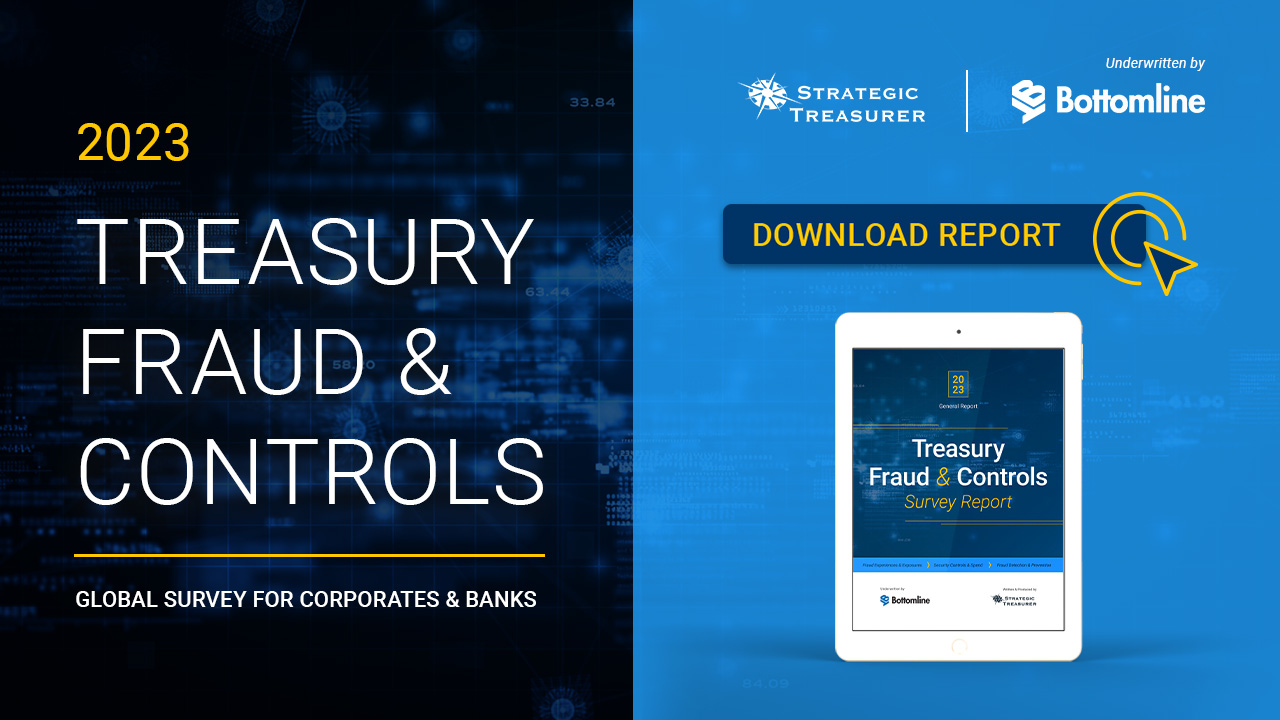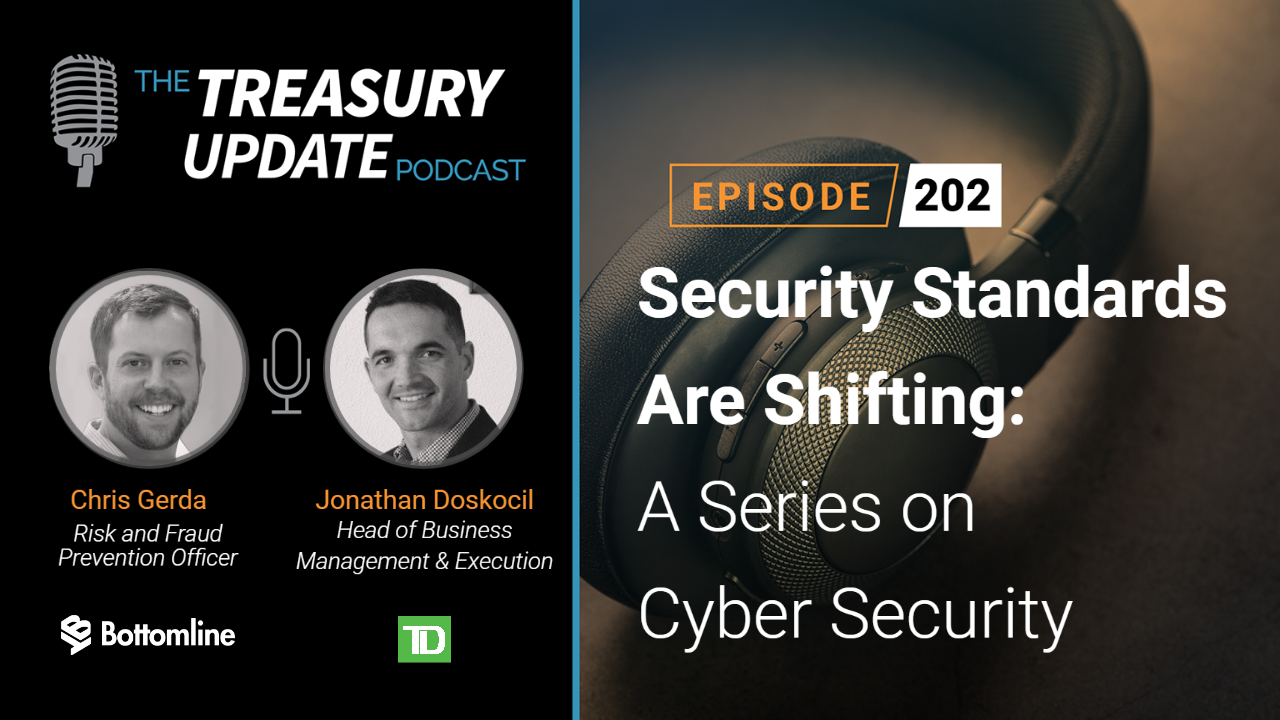
Episode 249
Fraud in a Changing Treasury Landscape Episode 1:
Are You Implementing Thoughtful Security?
Host:
Craig Jeffery, Strategic Treasurer


Speaker:
Omri Kletter, Bottomline


Episode Transcription - Episode #249 - Fraud in a Changing Treasury Landscape Episode 1: Are You Implementing Thoughtful Security?
Announcer 00:04
Welcome to the Treasury Update Podcast presented by Strategic Treasurer, your source for interesting treasury news, analysis, and insights in your car, at the gym, or wherever you decide to tune in.
Craig Jeffery 00:19
Welcome to the Treasury Update Podcast. This is Craig Jeffery, and I’m joined with Omri Kletter from Bottomline Technologies. Welcome to the podcast, Omri.
Omri Kletter 00:28
Good to be here again.
Craig Jeffery 00:30
We are discussing some of the outflows of the 2023, Treasury Fraud and Controls Survey. Some key findings that came out of this research, this is the eighth annual survey for Treasury Fraud and Controls, Bottomline has underwritten at all eight years. So we thank them and thank everybody who completed the survey. But let’s begin there’s four areas that I wanted to ask you about. The first is, you know, as we look at the results from the survey, the threat and reality of fraud continues to persist and grow significant issues with with fraud, continue to escalate and continue to elevate. And companies are certainly acknowledging this threat and a full 30% plan to spend more due to concerns of management. This is one of the key areas management concerns about fraud. So as you look at this, and as you’re in the space all the time, what are your concerns and observations about spend? What’s reactive? What’s proactive? How do you think about how should we be thinking about this?
Omri Kletter 01:30
Very good question, obviously. And I think many of the listeners for these podcasts are dealing with these questions day in day out, right, they have big responsibility on their shoulders, how to manage their organizations, fold controls, how to make sure that they are support their customer support, the management support, by the way, compliance and regulation elements and obviously do it with with the budget they have in front of them. One of the biggest concern I have is obviously to see or to ensure, as an industry, we are not forgetting that, while there are risks of let’s call it risk recession or different view around spending. We can’t We can’t necessarily leave this front unsecured. And it means two things. Obviously it means that for us is for experts and professionals we need to have we have more, I would say responsibility to make sure that we get our recommendations, right. Because many, many times organizations will have less flexibility around the spending, and we need to make sure that we are managing properly. So one, one concern is definitely to ensure that despite what we’re seeing around the industry that we are hiring less that we are not backfilling on attrition that we are sometimes having dramatic cuts across even the biggest players and the biggest, both banks and corporate data, we need to make sure that we don’t translate these many times right move to be smarter with our cost and delay critical decisions on protecting our footfall. So that’s number one. Number two, is I think it puts more on us we need to be smart on how we spend it. And my always my view that is that we need to balance between the different risks in front of us we can’t be over invested in one front, I think one of the things that I’m seeing very clearly is the need to have a I would say more comprehensive fold out, even with what are we protecting from. And a good example would be to make sure that our organizations are concerned or have have the ability to spend a security not not only from external types of risks, but also from inside risk or in negligence around how we deal with our cyber and monetary assets. These are the two things that I’ve mentioned the risk of the impact of recession or changing habits of spend. And then making sure the secondary obviously or concern is that we’ll make it right. I would write balance and not be over invested. Especially we are maybe budget will go down.
Craig Jeffery 04:05
You mentioned a couple of key things about about spending, spending things right. So this stewardship role of stewarding the resources. You know, the reaction of management is a key driver. right half of them said management is concerned about that. Number two was a related or recent security incident. And I’m wondering how much of how much of this reaction can create a maybe an overly rapid decision, as opposed to something that’s thoughtful, I guess you certainly can spend on security in inefficient ways, like in a reactive manner. How much of an issue is that? How much of that’s sub optimal just reacting as opposed to doing something more comprehensive or strategic?
Omri Kletter 04:46
I think you’re definitely correct touching one of the biggest challenges out there and how we balance between maintaining what we have and secure ending and then and sometimes it can be very cumbersome and how we make sure that we are also up to ate with with the recent elements. One of the things that we’ve discussed in in the recent recent webinar, for example, is the impact of instant payments, right, so and speedy payments. And that would be a good example with the need to update some of our protections and controls with the fact that we’ll need to react much faster, not necessarily all the time. So we can we have enough, you know, being big enough window of time to get the money back in case of fraud cases. So that’d be a good example of making sure that the latest and greatest changes to the industry are being answered and protected from right and instant payment would be a good example working from home risk and how we insure it. So I think, to your question, yes, you’re absolutely right, there is a higher concern for management. And rightly so because we are making it not only as a bigger risk, but also compliance threat many times. And sometimes, and again, something we discussed over the webinar will be called catastrophic loss really were a fraud cases can really take down the business or have a giant effect on that. So I think with that, we need to ensure that we are not only balancing between the different types of risks, but also to manage it right between keep investing what I would call legacy platforms and legacy activities that are out there, but addressing the new trends, and just to mention two of them that we’ve discussed heavily in the webinar, moving into working from home. And another, obviously important trend is their real time payments and instant payments, impact on how organizations are being protected.
Craig Jeffery 06:45
Thanks, Omri. And we’ll make sure you put a replay of the webinar that you’re referring to in the show notes. Now, Omri, maybe you just give everybody the one minute background, what do you do at bottom line? Where does your love for fraud and controls come come from?
07:03
So first of all, I think many of us, many of us, including the audience, once you go into the protection area, and once you go, you move your cursor in focusing on chasing the bad guys, it’s very hard to change it because it’s so fulfilling, so interesting. So dynamic, so tiring, frauds, but so I’m part of this wider group of fraud fighters. And I in the last few years I, I do it together with with both when I work with and for a bottom line, aim. Bottomline is a payments technology company. That’s why we’re also obviously very engaged with organizations like yourself, but being so focused on payments and providing a solutions for treasuries for banks and for a multinational organizations to send money in and receive money out or to, in other words, we, we tend to call it, pay and get paid. So that’s what Bottomline is doing day in day out. My responsibility within Bottomline is to run a line of business of fraud and financial crime where Bottomline on one hand, provides fraud and financial crime detection solution for the different organizations, but also support bottom line itself, because Bottomline is also a payment network operator we have, we’re very proud of our network in the US, named PaymodeX. And to whom of you will listen to the webinar will hear our chief fraud officer Chris Gerda talking about over there. So we are, on one hand, my division within Bottomline supports external customers around the world. And we do it in five continents 20 478. But we also protect our own networks, which keeps it quite unique. So we’re not just the solution vendor. Well, we also have the customers very close to us. It keeps the product very up to date. And interesting.
Craig Jeffery 08:48
Right. Our second area is related to this escalating war fraud is a fraud is a battle at least it’s probably a war. It’s an escalating war. The threat that everyone is facing is increasingly sophisticated and more automated. You know, we’ve heard we’ve always heard the phrase fight fire with fire. Maybe that’s relevant here. So how are companies expected to defend themselves against increasingly sophisticated and automated methods of attack?
09:19
So you’re absolutely right and we cannot avoid looking at it from a wider geopolitical and sociological almost point of view. And we understand his folly is on the rise because fraud became a very important and useful method for organized crime and in many times, it’s a state level weapon to attack organizations right so many of us do for members in our audience. Will will sit in different states in the US and other states they want to attack the US find attacking treasures and treasuries is one of the best tools to attack right to get money out of the organization. The overall you environment is is definitely a seeing this this right so you’re right to say that many of our people right the the the guys that are on the guard right now treasuries all four leaders within these accounts payable and and the groups that obviously follow your podcast understand responsibility and to answer your question how to deal with it first of all deal with it together, I think that’s why we’re, you know, engaging in these type of events because it’s important to bring the industry together, I think if we were siloed, not sharing best practices, not showing how we use technology, we are not doing well enough, I can tell you that we in bottom line, I was heavily invested to bring our customers together as and share information and techniques. And I think on that front, I would also suggest walk heavily. I think Chris mentioned a video with your banking partners, and in many times with regulators with law enforcement to ensure that you’re up to date and following the latest data. So I think, yes, fire, fight fire with fire, but fight fire with fire together in the industry.
Craig Jeffery 11:12
Fight fire with fire together. That’s, that’s awesome. So just a couple statistics. So artificial intelligence, machine learning, those who are using it for fraud detection, for example, the expectations that will move from 11%, or one out of nine companies to 24%, which is one out of four, so one out of nine to one out of four quickly. In fraud detection, biometrics comes up and moving from 8% to 16%. So a lot of room to grow, but some encouraging signs there. I want to thank you honoree for this brief podcast, we’re gonna do a part two, as well. There’s four really, really meaty areas that that we can talk about. And we’re going to pick this up in part two. So thank you for joining me on the Treasury Update Podcast.
Announcer 12:02
You’ve reached the end of another episode of the Treasury Update Podcast. Be sure to follow Strategic Treasurer on LinkedIn. Just search for Strategic Treasurer. This podcast is provided for informational purposes only, and statements made by Strategic Treasurer LLC on this podcast are not intended as legal, business, consulting, or tax advice. For more information visit and bookmark StrategicTreasurer.com.
Subscribe to the Treasury Update Podcast on your favorite app!
Related Resources
Treasury Fraud & Controls Report
This research discovered how your fraud experiences and security practices has changed. Has your security framework been strengthened? Is your outlook as positive as the industry’s outlook on the threat of fraud? What security threats are on the rise?
Security Standards Are Shifting: A Series on Cyber Security
Host Craig Jeffery sits down with Jonathan Doskocil of TD Bank and Christopher Gerda of Bottomline Technologies for the second conversation in this series concerning cyber security. This episode covers topics including changing security standards, growing risks, and the duty placed on companies to protect their people, data, and assets.








